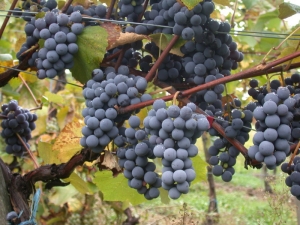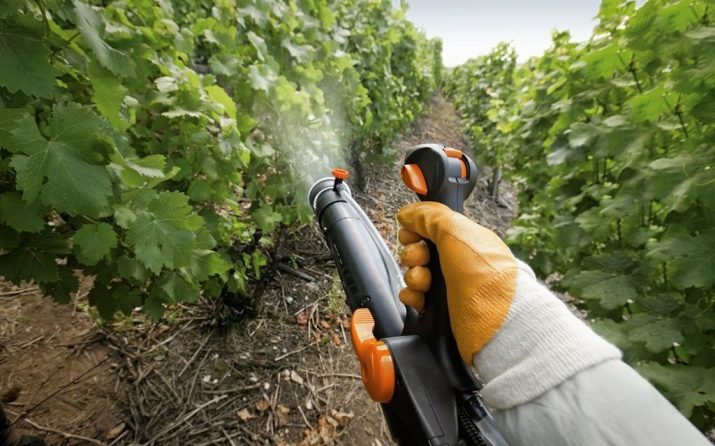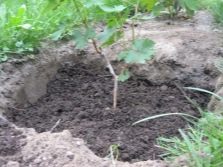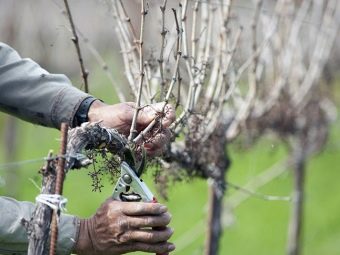Attika grapes: features of the variety and cultivation

Attika Sildis is a Greek grape variety that is a hybrid of the French Alfons Lavalle and the ancient Greek Kishmish Black. Early table seedless grapes with excellent taste. The hybrid got its name in honor of the region in the south-east of Greece.
Variety description
Attika is an early light-loving grape variety that ripens its fruits (from the beginning of bud opening), takes 120 days. In the southern regions, the harvest is ready by the end of July, in the middle lane, for example, in the Moscow region - by mid-August. Weather conditions affect fruiting, berries ripen faster in hot summer.
Berries
Ripe, oval-shaped, fruits, 20-25 mm in size, end in a small dimple in each grape. Depending on the period of aging, they have a color from bluish-purple to dark purple, or almost black. Berries weighing 4-5 g, do not contain seeds, but in large fruits (6-8 g) the presence of rudiments is sometimes observed.
Peel with a beautiful wax coating is strong enough, non-viscous, with a delicious crunch. Juicy fruit has a pleasant sweet taste with a hint of cherries and arnica. The flesh becomes saturated, dense and juicy only after full ripening. The fruit picks up a dark pigment early, but is not yet ready for use. The immature berry is tasteless and resembles mucus.
The tightly-seated stalk retains its berries well, so the grapes can remain on the bushes until frost. The aged fruits gain sweetness and juiciness, they contain sugar content up to 18%, acidity - 5%.
Clusters
Brushes hybrid "Attica" form a cone, have a moderate density of the fit of the berries. In the first year of fruiting small clusters grow. Subsequently, from an adult plant, they can reach a length of 30 cm and weigh from 700 g to 2 kg. For the season from one bush they collect from 20 to 30 bunches of grapes.
Leaves, inflorescences
The leaves are dark green, clearly defined, have well-marked veins. The plane of the sheet consists of three or five figured endings. The upper part is smooth matte, and the lower part is felt, as if covered with hairs, evaporates moisture less than the surface of the sheet. The flowers are bisexual, so the plant does not need additional pollination.
Features and specifications
The plant has an average strength of growth, but the active development of shoots. They have time to grow and get stronger before the onset of winter.
The culture is undemanding, well resistant to winter temperatures. Fruit buds easily tolerate twenty degrees of frost. Due to its frost resistance, Attica can be grown not only in the southern regions, but also in the middle lane. In the Krasnodar and Stavropol Territories, this variety is cultivated in large areas without covering the bushes during the winter period of time.
Yield
Hybrid variety Attika has high yields, 25 tons per hectare. Fruiting should be expected in the second year after planting. The bush during this period can give up to eight small clusters, with a total weight of about one kilogram. During the second fruiting, up to 5 kg of berries are harvested from one plant. Adult shrub gives 15-20 kg of fruit per year.
Pests
Culture has good resistance to pests and diseases. Especially good plant withstands gray rot. He is also not afraid of leafworms, wasps, spider mites. But for prevention, it is necessary to spray the fungicide several times during the season.
You should also make sure that the bushes do not overgrow with excess shoots - good ventilation of the plant reduces the risk of spreading parasites.
"Attica" is hardy and unpretentious, it will suit any soil, except for the swamp and salt marsh. Culture should be planted in spring or autumn. It actively grows on even, well-lit places, protected from drafts. Dense fleshy fruits are well stored and transported.
Advantages and disadvantages
After analyzing the characteristics of the variety, we can draw the following conclusions about the merits of the plant:
- high yield;
- balanced taste of berries;
- unpretentiousness in the choice of soil;
- frost resistance;
- the presence of an impressive size of clusters and large fruits;
- lack of care;
- resistance to pests;
- active growth of shoots - culture develops long before the onset of cold weather;
- strong structure;
- excellent keeping quality of fruits and lack of difficulties in transportation.
When working with Attika varieties, there may be certain difficulties that can hardly be called flaws, but you should pay attention to them. Among the negative points:
- the vine is prone to overloads, it is necessary to prune the bushes, leaving 30 eyes each, the rest are removed;
- the bush loves a lot of heat and light;
- need an optimal level of humidity.
Growing up
Landing
It is possible to dwell on planting young plants in more detail and gradually consider the whole process of planting a crop. Planting material must be healthy, about half a meter in height, have a strong root, with at least three branches.
Sapling before planting cut, leaving a few buds, and the sections are treated with paraffin. Then dig a hole with a depth of 30-40 cm, by volume of the root system. Before planting a plant, some fertilizer is added to the excavated soil. At the bottom of the hole, creating a drainage, spread crushed stone or broken brick, and sprinkle it on top of the prepared soil with phosphate or potash fertilizers. Nitrous during planting is not used, so as not to damage the weak roots.
The roots of the plant are dipped into a semi-fluid mixture of mullein (2 parts) and clay (1 part), carefully poured with the remaining soil with phosphates, tamping layer by layer. The seedling is watered abundantly and a mound is formed around it, into which a plastic tube can be inserted for subsequent dosed irrigation and feeding.
The grapes are planted in straight rows at a distance of two meters from each other.
Care
Initially, fragile cuttings are tied to pegs, which are gradually removed as the plants grow. In the future, the grapes should provide a vertical position, forming supports with the help of high posts and wire.
In addition to tying, the grapes need pruning, as it is overloaded with shoots. Excess weak vines should be removed, forming a bush massive but spacious. For the harvest to be of high quality, the number of inflorescences is regulated, leaving two buds on the shoot (in the southern regions) and 5-6 (in the middle lane). As a result, up to 30 buds remain on one bush.
"Attica" unpretentious and malleable, it can be grafted to any other rootstock.
Young grapes, with no precipitation, should be watered daily. A hardened plant is irrigated as needed.
Several times during the season the plants are fed. Nitrogenous fertilizers are applied just before flowering.
In central Russia, the shelter of bushes is required in preparation for the winter period. To do this, the vine is sprayed with a 5% solution of ferrous sulfate, removed from the supports and pressed to the ground, then warmed - for example, with pine branches. Adult plants are left on supports, but also insulated with organic materials (burlap, straw, coniferous branches).
Reviews
Analyzing reviews, you can note their positive attitude. Many gardeners noted excellent pollination, the absence of disease, dense berries, firmly gathered in clusters. Also, summer residents leave positive feedback on the number of berries. The taste is not distinguished by sophistication, it is completely simple, and this is probably its charm. For many Russian farmers, getting such a crop in an unstable climate is a great success.
Also, consumers claim that Attika grapes are good not only fresh. It turns out a lot of delicious dishes - compotes, jams, blanks. And "Attika" - one of the best varieties for making raisins.
Negative moments are associated with the taste of immature plants.Already noted feature "Attica" to gain juicy fruit, remaining on the bushes after ripening.
In addition, most summer residents know that difficulties in growing grapes can be associated not only with care, but also with the weather. So, quite a lot of gardeners talk about the cool summer and the subsequent taste of culture. There is immaturity, the absence of sweetness - the grapes are fresh in taste. However, the gardeners themselves confirm that patience must be exercised. Within a few weeks, the taste qualities of “Attica” change drastically and you can still have time to harvest before the cold weather.
Review of Attika grapes in the next video.










































